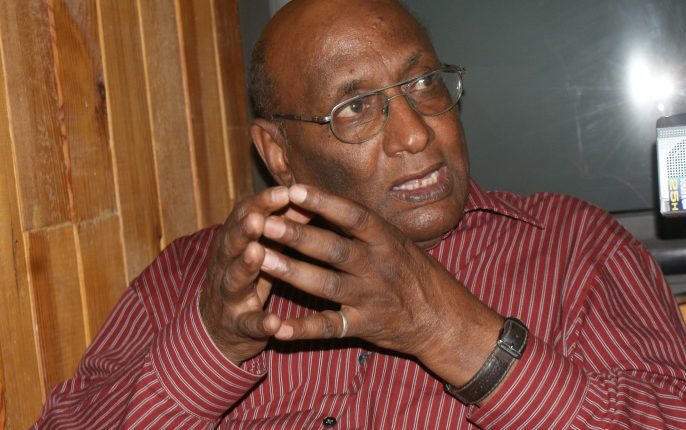كتب: د. عبد الله علي إبراهيم
.
لم تتفق لي غلبة صورة بطولة الأستاذ محمود محمد طه عند مشهد استشهاده، الذي تأيقن في بسمته الوضحاء، على صورة النذالة التي تآمرت لعقود لتقتل ذلك المفكر الجريء. فطغى رمز البطل على سفالات الخونة. والعلم بنذالات الخونة علم على حد السواء مع علم نبل البطل إن لم يكن فوقه درجة كما يحب الشهيد أن يقول. وسببي لرفع النذالة درجة أن الشهيد يبقى معنا ذكرى في حين يبقى فينا الأنذال سفاكي دماء وترياقاً للفكر أبدا.
هذا التغليب للبطولة على الخيانة هو ربما ما طرأ لي أول ما شاهدت فيديو محاكمة الشهيد واستتابة تلاميذه في وقت ما من التسعينات. وعصف المكر واللؤم والعهر الفكري فيه بنياط فكري. واتفق لي أن ما استحق التعريض به للعالمين هي تلك العصبة التي تضافرت لصنع ذلك المشهد الوقح في تاريخنا. وخططت لعمل إبداعي توثيقي يكون فيديو المحاكمة والاستتابة مركز الدائرة فيه
وتحدثت إلى عبد الله النعيم في القاهرة. ودلني على أن عطيات الأبنودي، السينمائية المصرية، فكرت بنفس فكرتي بل ربما شرعت في ما فكرت فيه. وكاتبت عطيات لاقترح عليها للغرض أن اتقدم بمشروعنا إلى جامعتي في ميسوري أطلب تمويلاً له. وبالفعل كتبت مسودة المشروع بغرض تقديمها لمجلس أبحاث الجامعة. ولسبب من تلك الأسباب توقفت الخطة عند ذلك الحد. ولا مزيد.
وأنشر في مناسبة الذكرى الثامنة والعشرين لاستشهاد الأستاذ محمود بعض النص الإنجليزي الذي حمل عقيدتي ألا نصرف النظر، في تثميننا المستحق لمأثرته في فداء الفكر، عن الخونة في مشهد مقتله. فلا نريد للجيل الطالع أن يرث من المأساة ملهمات فداء الأستاذ دون أن ننقش في أعمق خاطره استنكاراً فطرياً لوضاعات قتلته. وبدا أن صار فينا عادة نازع تمييز البطولة على الخيانة حتى استملحت مقطعاً من ود المكي قال يشكو من:
الشعر بفمه الأهتم وأنت بحفلات التأبين
THE RECANTATION FIELDS
DRAFT
A Documentary of a 1985 Recantation Ordeal Administered by the Clerical Class in Sudan on Five Men after the Execution of their Mentor and Islamic Reformer, M. M. Taha (78 years).
The Project
The project seeks to research, record/video and produce a documentary film of the execution of M. M. Taha (1909-1985), the Sudanese Islamic reformer, and the recantations of his disciples at the hands of Muslim clerics on January 18, 1985. The collection phase of the project will add to the image resources of the original video of the killing and recantations aired on the January 19, 1985. A dismayed viewer described the video as coming out of a Fellini film. In the collection phase I will seek primarily to tape the narratives of those who survived the ordeal by disgorging their views. In integrating these narratives, the fragments of minor actors, the project seeks to better understand the execution of Taha, enshrined as the Arab Day of Human Rights, monumentalized by various political concerns and lobbies have monumentalized for their own ends. The production phase will pick up from, and considerably transform, the unfinished work on the 1985 videotape undertaken by Ms. Attiyyat El Abnoudy, a renown Egyptian filmmaker and human right activist, who will be invited as a visiting scholar to campus to produce the film in connection with our award-winning Cooperative Video Group led by Mr. Frank Fillio.
The Killing and Recantation Fields
Taha and his Republican followers held a controversial version of Islamic revival dovetailing Sufism, modernityو and current notions of social justice. In The Second Message of Islam , translated from Arabic by his disciple, Abdullahi An-Na’im of Emory University School of Law, and published by Syracuse University Press in 1987, he argues that the foundation of Islam was built on two successive and layered messages. The First Message, tolerant and egalitarian, the Prophet preached in Mecca. After his flight to Medina, a shift took place. Here, God responded through the Prophet to the needs of a society at a level of development far below the ideals of the First Message. As a result, Taha argued, aspects of the earlier message were abrogated and obscured, although they remained operative at a moral/persuasive level. Taha concluded that the texts of the Second Message underpinned the development of the legal codes of the sharia which discriminate on grounds of sex and religion. A new era Islamic jurisprudence will begin, he argued, with the return to the Meccan texts which call for equality of all human beings.
Taha’s reform is gaining grounds among a contingency of Muslim secularists in the diaspora. An-Na’im (199? ) elaborates carefully how Taha’s reforms bridges the embarrassing chasm between Islam and modern notions of human rights while keeping the basic faith intact. Already Bilgrami, a philosopher of Muslim and Indian origin teaching at Columbia University, proposed the adoption of Taha’s platform to reconcile Islam and modernity (1992).
traditional sharia the human rights
Taha’s views were aggressively met by the clerical class in Sudan. They were extremely confused and revolted by his unsettling metaphors for reimagining a textually finished past. For advocating a Second Message of Islam, they dubbed him a “Latter-day Prophet “in a religion that revels in the fact that Muhammad is the seal of prophets. In their sacred rage, the clerics charged Taha of apostasy before the High Sharia Court in 1986 although its colonial and postcolonial jurisdiction did not extend to matters of belief and politics. Taha was found guilty and had Islam been the law of the land he would have been killed, his Muslim wife divorced from him, his corpse buried in non-Muslims’ graveyard and his disciples disbanded and asked to recant.
I would use the rivalry of the two court systems to better understand the execution of M. M. Taha, the modernist Islamic reformer hanged by Nimirei’s regime (1969-1985) in 1985. The documentary will show the killing of Taha and the recantation of his followers in 1985 were the delayed execution of the ruling passed by the High Sharia Court in 1968. The film will document the brutal fight between Taha and his adversaries that ensued after 1968 in which the clerics led a national and Pan-Islamic campaign to incapacitate him. Taha, on the other hand, never ceased rubbing in the colonial origins of the political impotence of the clerics. The film will highlight the political alliances and energies that made Taha’s delayed execution possible in 1985.
The Videotape and I
The macabre 1985 videotape has been haunting me since I watched it in 1987. Right there and then I envisioned how a carefully produced documentary of the video will bring out its disarming cinematic plea for human decency in Muslim politics. I was enraged rather by the recantation field for the mental emasculation these men had gone through in giving up an idea they piously espoused to reform the world and denouncing a teacher whose blood was still glistening on the cross. I decided to get back at the clerics when the first opportunity availed itself.
On the appointment of Mr. Mikashfi Kabbashi, the leader of the bullying clerics to a Saudi University in 1988, I issued singlehandedly a call for concerned scholars to stop this appointment. The call urged scholars to address the President of the Saudi University saying that:
We believe that Dr. Kabbashi’s record in eliminating intellectual rivals and pressuring them into disgorging their ideas disqualifies him as a potential faculty. Because he cannot stand a controversy, he is unlikely to encourage or reward his students for holding a competing perspective with his own.
My research praxis since I saw the original tape has been fuelled by my identity as a survivor of these extreme forms of the “aesthetics of vulgarity” (Mbembe 1992) in postcolonial Sudan.
I have been thinking ever since I was numbed by the tape about how to dissuade the unrelenting clerics from deploying their lethal fatwas (legal opinions) licencing the killing of “apostates” such as Salman Rushdie, the late Faraj Foda, Dr. Nasr Abu Zeid of Egypt, and a host of other reformers and modernists in the Muslim world. The chill these fatwas brought to the political and intellectual life scared people from political participation. Suffice it to say that Taha’s followers dropped out of sight as a political force and abstained from doing politics and preaching even during the brief of spell of democracy we enjoyed between 1985 and 1989. To breathe life in civil society, clerics should be forced to play in a levelled field relinquishing their usurped right to a monopoly of truth. I have always believed a subtle treatment of the 1985 tape of the recantation fields would bring out this argument loud and clear.


